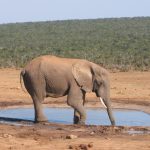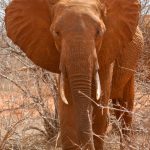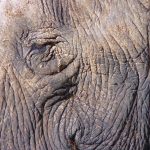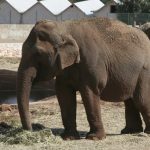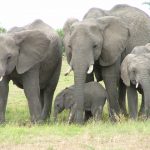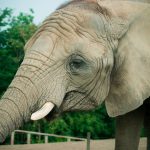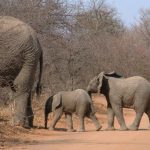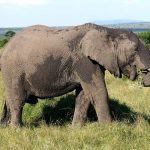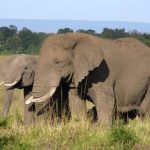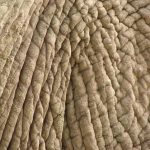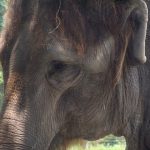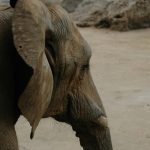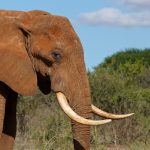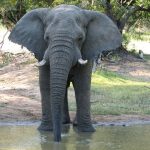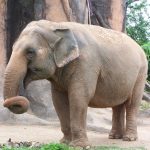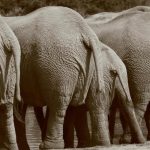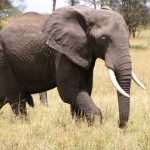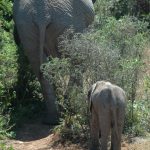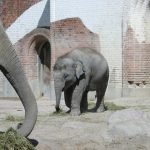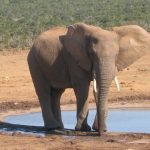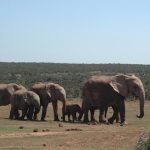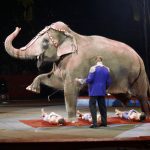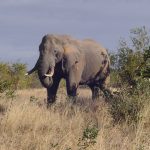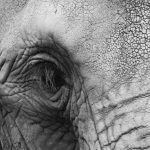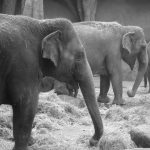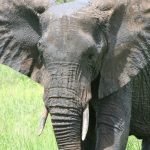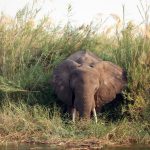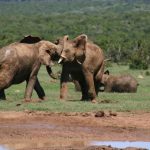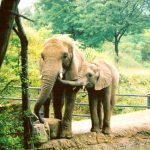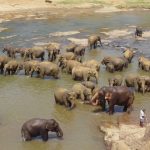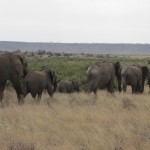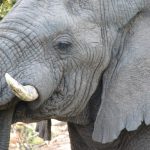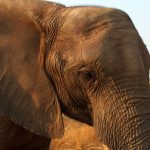- Elephant lives in family groups known as herds led by an older female who is the matriarch of the herd and uses her experience and old age to show it to food and water
- The male elephants end up dying of starvation
- Elephant Family in Masai Mara, Kenya, Africa. Old Photo from 1995.
- Male elephants remain with the herd only until the age of 12-13 while the female elephants stay with the same herd all its life
- Elephant has complex consciousness and strong emotions
- Tusks are enormous front teeth of the elephants that keep growing
- The tusks are enormous front teeth of the elephants
- Elephants have complex consciousness
- Elephants live in family groups
- Elephants have strong emotions and complex consciousness
- Older female that leads an elephant herd is the matriarch
- An elephant is extremely long-lived
- Kenyan elephants are long-lived, surviving to 60 to 70 years with male elephants often living longer than female
- Tusks are enormous front teeth of the elephant that keep growing throughout it’s life
- A male elephant often lives longer
- Male elephants only remain with the herd until the age of 12-13 after which they join a group of other males
- The female elephant stays with the same herd
- The male elephant only remains with the herd until the age of 12-13 after which it joins a group of other males known as a bachelor herd
- The Kenyan elephant is long-lived, surviving to 60 to 70 years with male elephants often living longer than female
- The male elephants remain with the herd until the age of 12-13
- The elephant lives in family groups known as herds led by an older female who is the matriarch of the herd and uses her experience and old age to protect the herd
- A Kenyan elephant is extremely long-lived surviving to 60 to 70 years
- Elephants live in family groups known as herds led by an older female who is the matriarch of the herd and uses her experience and old age to protect the herd
- Tusks are enormous front teeth of the elephant
- Across Africa elephant has inspired respect from the people
- Across Africa elephant has inspired respect from people giving it a strong cultural significance
- The elephant lives in family groups known as herds led by an older female
- An elephant has strong emotions and complex consciousness
- A male elephant only remains with the herd until the age of 12-13 after which it joins a group of other males
- The elephants play an important role in maintaining the biodiversity
- An older female is the matriarch of the elephant herd
- The elephants are icons of the continent
- Across Africa elephant has inspired respect from people that share the landscape giving it a strong cultural significance
- An elephant has complex consciousness and strong emotions
- Elephants often raise its trunk when trumpeting
- The Kenyan elephants are long-lived, surviving to 60 to 70 years with male elephants often living longer than females
- African elephants are extremely long-lived surviving to 60 to 70 years
- Male elephant often lives longer
- Across Africa the elephant has inspired respect from people giving it a strong cultural significance
- Elephant is an icon of the African continent
- Male elephants remain with the herd only until the age of 12-13 while the females stay with the same herd all its life
- Kenyan elephant is long-lived, surviving to 60 to 70 years with male elephants often living longer than females
- An elephant lives in family groups known as herds led by an older female who is the matriarch of the herd and uses her experience and old age to show it to food and water and to protect the herd
- Tusks of the elephant is used to dig for roots
- The threat to African elephant populations in Eastern Africa is increasing
- Elephants play an important role in maintaining the biodiversity
- Tusks of the elephants are enormous front teeth
- The elephant has complex consciousness and strong emotions
- The elephant has a complex consciousness
- The tusks of the elephants are used to dig for roots
- Male elephant only remains with the herd until the age of 12-13 after which it joins a group of other males known as a bachelor herd
- Elephants live in family groups known as herds
- Female elephants stay with the same herd
- Male elephant remains with the herd until the age of 12-13 after which it joins a group of other males
- Elephants are icons of the continent
- The tusks of elephant is used to dig for roots
- The elephants are very intelligent creatures
- Elephant has a complex consciousness
- Tusks are enormous front teeth of elephants
- The threat to the elephant populations in Eastern Africa is increasing as poaching is rising
- Across Africa the elephants have inspired respect from people that share the landscape
- A male elephant only remains with the herd until the age of 12-13 after which it joins a group of other males known as a bachelor herd or lives alone
- Male elephant only remains with the herd until the age of 12-13 after which it joins a group of other males
- Many thousands of elephants were killed between the years 70s and 90s for their ivory
- Across Africa the elephants have inspired respect from the people
- The elephant lives in family groups known as herds led by an older female who is the matriarch of the herd and uses her experience and old age to show it to food and water and to protect the herd
- Elephants do not digest much of the food
- The African elephants are extremely long-lived surviving to 60 to 70 years
- The elephants live in family groups known as herds led by an older female who is the matriarch of the herd and uses her experience and old age to protect the herd
- The tusks are enormous front teeth of elephants
- The older female leads the elephant herd
- Tusks are enormous front teeth of elephants that keep growing
- The older female who is the matriarch of an elephant herd leads it and uses her experience and old age to protect and show it to water and food
- Elephant plays an important role in maintaining the biodiversity
- Female elephants stay with the same herd all its life while the males remain with the herd only until the age of 12-13
- Threat to the elephant populations in Eastern Africa is increasing as poaching is rising
- The female elephants stay with the same herd
- The male elephant only remains with the herd until the age of 12-13 after which it joins a group of other males known as a bachelor herd or lives alone
- Across Africa elephants have inspired respect from people that share the landscape
- Elephant poaching is rising
- The elephant lives in family groups
- Across Africa the elephant has inspired respect from people that share the landscape giving it a strong cultural significance
- The male elephant remains with the herd until the age of 12-13 after which it joins a group of other males
- The male elephants only remain with the herd until the age of 12-13 after which they join a group of other males
- Tusks are enormous front teeth of elephants that keep growing throughout it’s life
- Male elephant only remains with the herd until the age of 12-13 after which it joins a group of other males known as a bachelor herd or lives alone
- Elephant is capable of strong emotions
- Elephants belong to the Chordata Phylum
- The male elephants remain with the herd until the age of 12-13 after which it joins a group of other males
- The male elephants remain with the herd until the age of 12-13 after which it joins a group of other males known as a bachelor herd
- Male elephant remains with the herd until the age of 12-13
- Elephant lives in family groups
- The male elephant ends up dying of starvation
- Older female leads an elephant herd
- Threat to eastern African elephant populations is increasing
- Elephants belong to the Vertebrata subphylum
- Kenyan elephant is extremely long-lived
- Elephants belong to the Elephantidae family
- An elephant is a tourism magnet as it is the icon of the continent
- Elephants live in family groups known as herds led by an older female who is the matriarch of the herd
- The elephant lives in family groups known as herds led by an older female who is the matriarch of the herd
- Elephants often surround their calves as a way of protecting them
- Across Africa an elephant has inspired respect from people giving it a strong cultural significance
- The male elephants often live longer than female elephants
- Male elephants only remain with the herd until the age of 12-13 after which they join a group of other males known as a bachelor herd or lives alone
- Tusks are enormous front teeth of elephant
- The female elephant stays with the same herd all its life
- Male elephants often live longer
- Threat to the eastern African elephant populations is increasing
- The scientists reckon that elephants prefer their left or right tusk just like we do our left or right hand
- The tusks of elephants are enormous front teeth
- An older female who is the matriarch of an elephant herd leads it and uses her experience and old age to protect and show it to food and water
- Female elephant stays with the same herd all its life
- Older female leads the elephant herd
- A male elephant remains with the herd until the age of 12-13 after which it joins a group of other males
- An older female is the matriarch in the elephant herd
- Many thousands of elephants were killed between the years 70s and 90s leaving the African elephant populations at a number of 300,000–600,000
- An elephant lives in family groups known as herds led by an older female
- Elephant lives in family groups known as herds led by an older female who is the matriarch of the herd
- The elephants have complex consciousness
- Male elephants remain with the herd until the age of 12-13
- Many thousands of elephants were killed between the years 70s and 90s for their ivory, leaving the elephant populations at a number of 300,000–600,000
- Elephant is a tourism magnet as it is the icon of the continent
- The elephants have strong emotions and complex consciousness
- Elephants are capable of strong emotions
- The elephant drinks water using its trunk
- Elephants are extremely long-lived
- The threat to eastern African elephant populations is increasing
- The elephant is a tourism magnet as it is the icon of the continent
- An older female who is the matriarch of the elephant herd leads it and uses her experience and old age to protect and show it to food and water
- Male elephant often lives longer than female elephants
- A male elephant only remains with the herd until the age of 12-13 after which it joins a group of other males known as a bachelor herd
- The male elephants only remain with the herd until the age of 12-13 after which it joins a group of other males known as a bachelor herd
- The Kenyan elephant is extremely long-lived
- The tusks of elephant is used to dig for roots and hold grass in place
- An elephant is an intelligent creature with complex consciousness and strong emotions
- Elephant is extremely long-lived
- The older female that leads an elephant herd is the matriarch
- An older female that leads an elephant herd is the matriarch
- Across Africa the elephant has inspired respect from people that share the landscape
- The Kenyan elephant is extremely long-lived surviving to 60 to 70 years
- Kenyan elephant is extremely long-lived surviving to 60 to 70 years
- Tusks of elephant is used to dig for roots
- The tusks are enormous front teeth of elephants that keep growing
- An elephant lives in family groups known as herds led by an older female who is the matriarch of the herd
- An elephant has a complex consciousness
- Across Africa elephant has inspired respect from people that share the landscape
- The elephant is extremely long-lived
- Between the years 70s and 90s thousands of elephants were killed
- Across Africa the elephants have inspired respect from people giving them a strong cultural significance
- Elephants belong to the Animalia kingdom
- Tusks of elephants are enormous front teeth
- The elephant is an intelligent creature with complex consciousness and strong emotions
- Male elephant remains with the herd until the age of 12-13 after which it joins a group of other males known as a bachelor herd
- The tusks of the elephants are enormous front teeth
- The male elephants only remain with the herd until the age of 12-13 after which they join a group of other males known as a bachelor herd or lives alone
- The Kenyan elephants are extremely long-lived
- A family of elephants bath together, a behaviour which reinforces social bonding
- The elephants have complex consciousness and strong emotions
- Elephants are tourism magnets
- An elephant lives in family groups known as herds led by an older female who is the matriarch of the herd and uses her experience and old age to protect the herd
- Threat to elephant populations in Eastern Africa is increasing as poaching is rising
- The elephants live in family groups known as herds led by an older female who is the matriarch of the herd
- Elephants are tourism magnets as they are the icons of the continent
- The male elephant remains with the herd until the age of 12-13 after which it joins a group of other males known as a bachelor herd
- Thousands of elephants were killed between the years 70s and 90s for their ivory, leaving the elephant populations at a number of 300,000–600,000
- Older female that leads an elephant herd is called the matriarch
- The male elephant often lives longer than female elephants even to 90 years old
- The elephant lives in family groups known as herds led by an older female who is the matriarch of the herd and uses her experience and old age to show it to food and water
- Across Africa an elephant has inspired respect from the people
- Male elephants only remain with the herd until the age of 12-13 after which it joins a group of other males known as a bachelor herd
- The elephants are capable of strong emotions
- The Kenyan elephant is long-lived, surviving to 60 to 70 years with male elephants often living longer than females
- Kenyan elephants are long-lived, surviving to 60 to 70 years with male elephants often living longer than females
- Males remain with the herd only until the age of 12-13 while the female elephants stay with the same herd all its life
- A male elephant remains with the herd until the age of 12-13
- Across Africa elephants have inspired respect from people giving them a strong cultural significance
- The elephants are tourism magnets as they are the icons of the continent
- The elephant has strong emotions and complex consciousness
- Thousands of elephants were killed between the years 70s and 90s leaving the populations at a number of 300,000–600,000
- A male elephant remains with the herd until the age of 12-13 after which it joins a group of other males known as a bachelor herd
- Threat to the African elephant populations in Eastern Africa is increasing
- Thousands of elephants were killed between the years 70s and 90s
- Across Africa the elephants has inspired respect from the people
- One year old Elephant – Ludwig – walking
- Elephant is an icon of the continent
- The threat to elephant populations in Eastern Africa is increasing as poaching is rising
- Many thousands of elephants were killed between the years 70s and 90s leaving the elephant populations at a number of 300,000–600,000
- The male elephant often lives longer
- The male elephant often lives longer than female elephants
- Elephants live in family groups known as herds led by an older female who is the matriarch of the herd and uses her experience and old age to show it to food and water
- The scientists reckon that the elephants prefer their left or right tusk just like we do our left or right hand
- The elephants live in family groups known as herds led by an older female who is the matriarch of the herd and uses her experience and old age to show it to food and water and to protect the herd
- An older female who is the matriarch of an elephant herd leads it and uses her experience and old age to protect and show it to water and food
- The male elephant only remains with the herd until the age of 12-13 after which it joins a group of other males
- An elephant lives in family groups known as herds led by an older female who is the matriarch of the herd and uses her experience and old age to show it to food and water
- Tusks of the elephants are used to dig for roots
- The Kenyan elephants are extremely long-lived surviving to 60 to 70 years
- Male elephants remain with the herd until the age of 12-13 after which it joins a group of other males known as a bachelor herd
- The threat to the African elephant populations in Eastern Africa is increasing
- A female elephant stays with the same herd all its life
- Elephant has strong emotions and complex consciousness
- The tusks of the elephant is used to dig for roots
- Threat to African elephant populations in Eastern Africa is increasing
- Elephant lives in family groups known as herds led by an older female who is the matriarch of the herd and uses her experience and old age to protect the herd
- Elephants live in family groups known as herds led by an older female who is the matriarch of the herd and uses her experience and old age to show it to food and water and to protect the herd
- Across Africa elephants have inspired respect from people that share the landscape giving them a strong cultural significance
- The elephant is capable of strong emotions
- Elephants are intelligent creatures with complex consciousness and strong emotions
- A Kenyan elephant is extremely long-lived
- The older female is the matriarch in the elephant herd
- The elephants are intelligent creatures with complex consciousness and strong emotions
- Adult male elephants spend their time in single-sex groups or alone
- A female elephant stays with the same herd
- Between the years 70s and 90s many thousands of elephants were killed
- The tusks of elephants are used to dig for roots
- Elephants belong to the Mammalia class
- Kenyan elephants are extremely long-lived surviving to 60 to 70 years
- A male elephant ends up dying of starvation
- Kenyan elephants are extremely long-lived
- The tusks are enormous front teeth of elephants that keep growing throughout it’s life
- Scientists reckon that the elephants prefer their left or right tusk just like we do our left or right hand
- Male elephants remain with the herd until the age of 12-13 after which it joins a group of other males
- A Kenyan elephant is long-lived, surviving to 60 to 70 years with male elephants often living longer than females
- Across Africa an elephant has inspired respect from people that share the landscape giving it a strong cultural significance
- The male elephants often live longer
- Elephants belong to the Afrotheria superorder
- The older female is the matriarch of the elephant herd
- Tusks of elephants are used to dig for roots
- Elephants belong to the Proboscidea order
- Older female is the matriarch of the elephant herd
- 0961020075121T096102T000L00000V150F0078F100000N0184P0000N033A000J1920J001J-01J0140S0000S0017S0017S0010S0007S0002S-017E0184184078104083096087086000000000000078001
- Thousands of elephants were killed between the years 70s and 90s leaving the African elephant populations at a number of 300,000–600,000
- Elephants belong to the Afrotheria superorder
- Thousands of elephants were killed between the years 70s and 90s leaving the elephant populations at a number of 300,000–600,000
- Elephant is an intelligent creature with complex consciousness and strong emotions
- The elephant is an icon of the continent
- The Kenyan elephants are long-lived, surviving to 60 to 70 years with male elephants often living longer than female
- The threat to Eastern African elephant populations is increasing as poaching is rising
- Across Africa elephants have inspired respect from the people
- The female elephants stay with the same herd all its life while the male elephants remain with the herd only until the age of 12-13
- Older female is the matriarch in the elephant herd
- An elephant lives in family groups
- Scientists reckon that elephants prefer their left or right tusk just like we do our left or right hand
- Thousands of elephants were killed between the years 70s and 90s for their ivory
- Male elephant ends up dying of starvation
- The elephants live in family groups
- The elephants live in family groups known as herds led by an older female who is the matriarch of the herd and uses her experience and old age to show it to food and water
- Across Africa the elephants have inspired respect from people that share the landscape giving them a strong cultural significance
- Female elephant stays with the same herd
- Elephants have complex consciousness and strong emotions
- An elephant is capable of strong emotions
- An elephant is an icon of the continent
- Tusks are enormous front teeth of an elephant
- The tusks are enormous front teeth of the elephants that keep growing
- Many thousands of elephants were killed between the years 70s and 90s
- Threat to the Eastern African elephant populations is increasing as poaching is rising
- Tusks are enormous front teeth of the elephants
- Many thousands of elephants were killed between the years 70s and 90s leaving the populations at a number of 300,000–600,000
- The threat to the Eastern African elephant populations is increasing as poaching is rising
- Elephant lives in family groups known as herds led by an older female
- Across Africa an elephant has inspired respect from people that share the landscape
- An older female leads the elephant herd
- Female elephants stay with the same herd all its life while the male elephants remain with the herd only until the age of 12-13
- Elephants live in family groups known as herds led by an older female
- The male elephant remains with the herd until the age of 12-13
- Asian elephant is one of the species of elephants that is traditionally recognized
- Elephant lives in family groups known as herds led by an older female who is the matriarch of the herd and uses her experience and old age to show it to food and water and to protect the herd
- The threat to the eastern African elephant populations is increasing
- The elephants live in family groups known as herds led by an older female
5 facts about elephant
- Homosexual behavior is frequent among elephants
- Asian elephants greet each other by inter-twining their trunks
- African forest elephants and African bush elephants are separate species
- Elephant numbers are severly depleted due to ivory trade
- Elephant is the largest land mammal on earth
To receive a colourful digibook about elephant with videos, images and text, please fill out the following form or simply email us on safaris@safari-center.com









